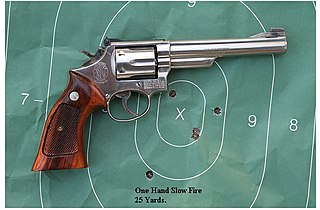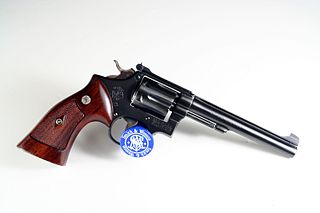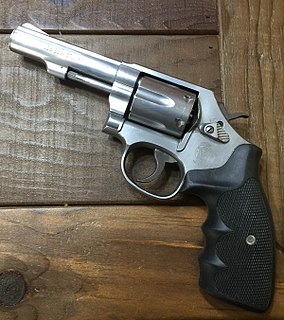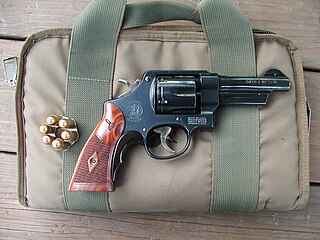Related Research Articles

A revolver is a repeating handgun that has at least one barrel and uses a revolving cylinder containing multiple chambers for firing. Before firing a round, cocking the hammer partially rotates the cylinder, indexing one of the cylinder chambers into alignment with the barrel, allowing the bullet to be fired through the bore. The hammer cocking can be achieved by either the user manually pulling the hammer back, via internal linkage relaying a rearward movement of the trigger, or both. By sequentially rotating through each chamber, the revolver allows the user to fire multiple times until having to reload the gun, unlike older single-shot firearms that had to be reloaded after each shot.

The Smith & Wesson Model 29 is a six-shot, double-action revolver chambered for the .44 Magnum cartridge and manufactured by the United States company Smith & Wesson.

The Smith & Wesson Model 19 is a revolver produced by Smith & Wesson that was introduced in 1957 on its K-frame. The Model 19 is chambered for .357 Magnum. The K-frame is somewhat smaller and lighter than the original N-frame .357, usually known as the Smith & Wesson Model 27. A stainless steel variant of the Model 19, the Smith & Wesson Model 66, was introduced in 1971.

The Smith & Wesson Model 10, previously known as the Smith & Wesson .38 Hand Ejector Model of 1899, the Smith & Wesson Military & Police or the Smith & Wesson Victory Model, is a K-frame revolver of worldwide popularity. In production since 1899, the Model 10 is a six-shot, .38 Special, double-action revolver with fixed sights. Over its long production run it has been available with barrel lengths of 2 in (51 mm), 2.5 in (64 mm), 3 in (76 mm), 4 in (100 mm), 5 in (130 mm), and 6 in (150 mm). Barrels of 2.5 inches (64 mm) are also known to have been made for special contracts. Some 6,000,000 of the type have been produced over the years, making it the most popular handgun of the 20th century.

A moon clip is a ring-shaped or star-shaped piece of metal designed to hold multiple cartridges together as a unit, for simultaneous insertion and extraction from a revolver cylinder. Moon clips may either hold an entire cylinder's worth of cartridges together, half a cylinder, or just two neighboring cartridges. The two-cartridge moon clips can be used for those revolvers that have an odd number of loading chambers such as five or seven and also for those revolvers that allow a shooter to mix both rimless and rimmed types of cartridges in one loading of the same cylinder.

The Smith & Wesson Model 686 is a six- or seven-shot double-action revolver manufactured by Smith & Wesson and chambered for the .357 Magnum cartridge; it will also chamber and fire .38 Special cartridges. Smith & Wesson introduced the Model 686 in 1981. It is the stainless steel version of the Model 586, which featured a blued steel finish. They are available ported and unported with a choice of 6- or 7-round cylinders.

The Smith & Wesson Model 625, is a six-round, double-action revolver chambered for the .45 ACP using moon clips. The Model 625 is an improved stainless steel version Smith & Wesson Model 22 and a direct descendant of the Smith & Wesson M1917 revolver first issued during World War I.

The M1917 Revolvers were six-shot, .45 ACP, large frame revolvers adopted by the United States Military in 1917, to supplement the standard M1911 pistol during World War I. There were two variations of the M1917, one made by Colt and the other by Smith & Wesson. They used moon-clips to hold the cartridges in position, facilitate reloading, and to aid in extraction since revolvers had been designed to eject rimmed cartridges and .45 ACP rounds were rimless for use with the magazine-fed M1911. After World War I, they gained a strong following among civilian shooters. A commercial rimmed cartridge, the .45 Auto Rim, was also developed, so M1917 revolvers could eject cartridge cases without using moon-clips.

The Smith & Wesson Model 17 is a six-shot double-action revolver chambered for .22 LR. It is built on Smith & Wesson's medium-sized K-frame.

A snubnosed revolver is any small, medium, or large frame revolver with a short barrel, which is generally 3 inches or less in length. Smaller revolvers are often made with "bobbed" or "shrouded" hammers, and there are even "hammerless" models, all allowing the gun to be drawn quickly with little risk of it snagging on clothing. The shrouded and hammerless models may even be fired through a coat or jacket pocket. The design of these revolvers sacrifices power and range for maneuverability and concealment.

The Ruger Redhawk is a DA/SA, large-frame revolver that was first introduced in 1979 by Sturm, Ruger & Company. Made from high-grade steel, it is available in a stainless steel finish. The Redhawk is reinforced to handle extra stress, making it very popular for use by handloaders as it is able to handle both .45 Colt and .44 Magnum loads. In addition, the cylinder itself is longer than most competitors', allowing ammunition to be loaded to a longer overall length. This allows for either increased powder capacity, heavier bullets without compromising the powder load, or a combination of both. Custom ammunition manufacturers even have loads made specifically for Ruger revolvers that cannot fit in shorter chambers or revolvers of weaker construction. This makes the Redhawk popular as a bear defense gun among hunters and trappers.

The Smith & Wesson Model 64Military and Police revolver is the stainless steel version of the Model 10.

S&W Centennial is a family of revolvers made by Smith & Wesson on the "J-Frame". Depending upon caliber, the cylinder holds either 5, 6, 7, or 8, cartridges. Centennials feature a fully enclosed (internal) hammer, which makes them Double Action Only (DAO) firearms. Like all other "J-frame" Smith & Wesson revolvers, they have a swing-out cylinder. Centennial models have been made in different versions like PD "Personal Defense", LS "Lady Smith", and M&P "Military & Police"

The Smith & Wesson Model 60 revolver is a 5-shot revolver that is chambered in either .38 Special or .357 Magnum calibers. It was the first revolver produced from stainless steel.

In firearms, the cylinder is the cylindrical, rotating part of a revolver containing multiple chambers, each of which is capable of holding a single cartridge. The cylinder rotates (revolves) around a central axis in the revolver's action to sequentially align each individual chamber with the barrel bore for repeated firing. Each time the gun is cocked, the cylinder indexes by one chamber. Serving the same function as a rotary magazine, the cylinder stores ammunitions within the revolver and allows it to fire multiple times before needing to reload.
The Smith & Wesson 340PD is an ultra-light J-frame five shot snubnosed revolver chambered for .357 Magnum.

The Smith & Wesson Model 22 is a 6-shot, double-action, large frame revolver chambered in .45 ACP using moon clips. It's a refined commercial version of the M1917 revolver first issued during World War I.

The Model 610 is a six-shot, double-action revolver chambered for the 10mm Auto cartridge.

The Smith & Wesson Model 640 revolver is a 5-shot snubnosed revolver that is chambered in either .38 Special or .357 Magnum caliber introduced in 1990. Like other "J-frame" Smith & Wesson revolvers, it has a swing-out cylinder, but this model features a concealed hammer, and is part of the Centennial line.

The Smith & Wesson Governor is a snub-nosed single-action/double-action revolver built on the Z-frame and utilizes a K-frame grip with a lightweight scandium alloy or stainless steel frame.
References
- 1 2 Supica, Jim; Nahas, Richard (2006). Standard Catalog of Smith & Wesson. Iola, Wisconsin: Gun Digest Books. pp. 265, 361. ISBN 1-4402-2700-4.
- ↑ Sweeney, Patrick (2004). The Gun Digest Book of Smith & Wesson. Iola, Wisconsin: Gun Digest Books. p. 29. ISBN 0-87349-792-9.